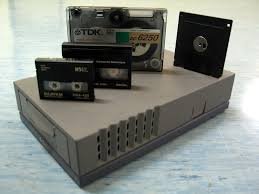The Ultimate Guide to Tape Drives and Tape Media
In the digital age, where data is growing at an unprecedented rate, reliable and cost-effective storage solutions have become paramount. Tape drives and tape media continue to be a trusted choice for businesses and individuals seeking secure data storage. This blog explores everything you need to know about tape drives, tape media, and their enduring relevance in modern storage solutions.

Introduction
In the digital age, where data is growing at an unprecedented rate, reliable and cost-effective storage solutions have become paramount. Tape drives and tape media continue to be a trusted choice for businesses and individuals seeking secure data storage. This blog explores everything you need to know about tape drives, tape media, and their enduring relevance in modern storage solutions.
What Is a Tape Drive?
Understanding Tape Drives
A tape drive is a data storage device that reads and writes data on magnetic tape. Unlike traditional hard drives or solid-state drives, tape drives store data sequentially, making them ideal for archiving and backup purposes. Tape drives are widely used in industries that handle large volumes of data, such as healthcare, finance, and entertainment.
History of Tape Drives
Tape drives have a long history dating back to the 1950s. Initially used in mainframe computers, they have evolved significantly over the decades. Modern tape drives are more compact, reliable, and capable of storing massive amounts of data.
Why Choose Tape Drives?
-
Cost-Effectiveness: Tape drives offer a lower cost per gigabyte compared to other storage solutions.
-
Long-Term Reliability: Tape media can last for decades if stored properly.
-
Scalability: Tape drives can accommodate growing storage needs without frequent upgrades.
Exploring Tape Media
What Is Tape Media?
Tape media refers to the magnetic tape used in tape drives for data storage. It is known for its durability and capacity, making it a popular choice for long-term data retention and archival.
Types of Tape Media
-
LTO (Linear Tape-Open): The most common type of tape media, offering high capacity and compatibility across different systems.
-
DAT (Digital Audio Tape): Often used for smaller-scale backups.
-
DLT (Digital Linear Tape): Known for its high speed and capacity.
Advantages of Tape Media
-
Durability: Resistant to environmental factors such as humidity and temperature.
-
High Capacity: Modern tape media can store up to several terabytes of data.
-
Security: Data stored on tape media is less vulnerable to cyber threats compared to online storage solutions.
Benefits of Using Tape Drives and Tape Media
1. Cost-Effective Storage
Tape drives and tape media offer a budget-friendly solution for large-scale data storage, making them ideal for businesses with tight budgets.
2. Secure Backup Solution
Offline storage on tape media minimizes the risk of data breaches and ransomware attacks.
3. Energy Efficiency
Unlike always-on hard drives, tape drives consume minimal energy when not in use, contributing to lower operational costs.
4. Longevity
Tape media has an impressive lifespan, often exceeding 30 years, ensuring that archived data remains intact for decades.
5. Scalability
Adding more tape cartridges to an existing tape library is a simple way to expand storage capacity.
How to Use Tape Drives Effectively
Setting Up a Tape Drive
-
Choose the Right Tape Drive: Select a tape drive that matches your storage needs and system compatibility.
-
Install the Drive: Connect the tape drive to your computer or server and install the necessary drivers.
-
Load the Tape Media: Insert the tape cartridge into the drive and initialize it.
-
Backup and Restore: Use backup software to manage data transfer to and from the tape drive.
Best Practices
-
Label Your Tapes: Clearly label each tape for easy identification.
-
Store Tapes Properly: Keep tape media in a cool, dry place to prevent degradation.
-
Regular Maintenance: Clean the tape drive heads periodically to ensure optimal performance.
Future of Tape Drives and Tape Media
Despite the rise of cloud storage and other digital storage solutions, tape drives and tape media remain relevant. Innovations in tape technology continue to push the boundaries of capacity, speed, and reliability. The future of tape storage looks promising, with advancements such as:
-
Increased Tape Density: New materials and technologies allow for higher data storage per tape.
-
Improved Data Access Speeds: Enhancements in drive technology reduce the time needed to access stored data.
-
Eco-Friendly Solutions: Tape storage consumes less energy, aligning with sustainability goals.
Conclusion
Tape drives and tape media offer a reliable, cost-effective, and secure solution for data storage. Whether you're a business managing vast data archives or an individual seeking long-term storage, tape technology continues to be a viable choice. By understanding their benefits and following best practices, you can maximize the value of tape storage in your data management strategy.
FAQs About Tape Drives and Tape Media
1. What is the lifespan of tape media?
Tape media can last over 30 years if stored in proper conditions, such as a cool and dry environment.
2. How much data can modern tape drives store?
Modern tape drives, such as LTO-9, can store up to 18 TB of uncompressed data and 45 TB of compressed data.
3. Are tape drives compatible with all operating systems?
Most tape drives are compatible with major operating systems, including Windows, macOS, and Linux. Always check compatibility before purchasing.
4. Can tape media be reused?
Yes, tape media can be reused after erasing the existing data. However, frequent reuse may reduce its lifespan.
5. Is tape storage suitable for small businesses?
Absolutely. Tape storage offers an affordable and scalable solution for small businesses with moderate data storage needs.
What's Your Reaction?















